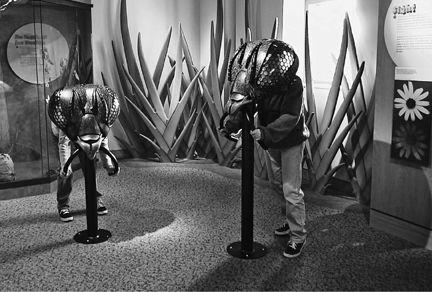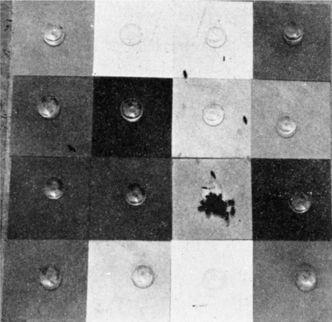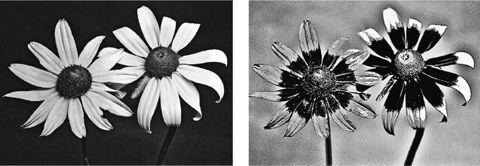Insectopedia (47 page)

It is mid-2010 or further into the future, and here we are again, caught between the unavoidability of comparison and the awareness of fundamental difference. Here we are still, caught in that imperative to understand, bearing our various tools for analysis and interpretation, trying to locate both the objective principles and the lived life in the enigmatic clues of observed behavior. Here we are again, caught somewhere between the reduction that makes things fathomable and the generosity that gives them fullness. Here we are, caught looking yet again, still looking, this time at tiny flies and their shiny gifts.
U
nseen
1.
Sometimes late at night I hear rustling. I work here, upstairs in my room, writing this book at the top of the building, perched on the roof, thinking about insects and all the things they make and do, sitting at my desk in this squat box coated black with pitch to protect against the city rain.
There are grilles on the windows. But there’s also a sliding door, and if you step outside onto the squishy silver-coated tar and look to the left, the sweep of the Hudson will catch your breath, especially in winter, when the trees are bare and the lights of New Jersey glitter in the river’s laquered blackness.
In the daytime, white egrets and red-tailed hawks fly past on their way to Central Park. Cardinals, finches, blue jays, squeaky mourning doves, and raggedy pigeons perch on our railing. At dusk, the sparrows go crazy in the trees below. A little later, Sharon and I head downstairs into Riverside Park, down past the Amtrak tunnel where Brooklyn (six years in the Marines, twenty-four on the streets) sleeps with her cats and raccoons, and where we watch the urban wildlife forage garbage in the gloom of the streetlamps.
It’s peaceful upstairs in this blanket of quiet. Night falls, and one by one the lights go out in the surrounding apartment buildings. The rush of traffic on the Westside Highway subsides. The last planes pass overhead. The quiet deepens, and we all head into the darkness.
Up here, at the top of the building, I turn my desk light down. I lower the brightness on my laptop. My eyes struggle against the dimness, then relax. Everything slows.
Sometimes in summer, when it’s hot and humid, the night is interrupted by rustling. It’s not the mice in the drywall or the squirrels in the guttering. It’s not the hairy centipedes that scamper into the corners. It’s not the mosquitoes or bluebottles or those erratic crane flies. It’s not the ladybugs or winged ants that arrive each year en masse without warning and just as abruptly disappear. It’s not the building stretching in the breeze. It’s not the leaves blowing up against the windows. It’s not a mystery. I know what it is. It’s the big water bugs, the American cockroaches, come to scratch along the walls, doing what they do, going from place to place, up from the drains, not really wanting to be here, a bit lost, looking for something.
Kikuo Itaya, the twentieth-century Zen Buddhist short story writer, lived among cockroaches, refusing to harm them, allowing them to share his home. But he was unusual, even in Japan. I think of him when I kill them. I have to kill them because Sharon is phobic; she freaks out when she sees one: she hides, she shakes, her body goes into spasm. Once she’s seen one, I can’t just pretend to have killed it. If I do, it will only break cover again, and everything will be worse than before. And anyway, she knows when I lie.
When I hear the scratching, I turn the lights down even further. My skin crawls in anticipation. If she doesn’t see it, if I don’t see it, if it remains unseen … I don’t want to know it’s there.
But sometimes the scratches are too insistent. One night, distracted and without thinking, I swiveled around. A healthy-looking water bug was sitting on a pile of books behind my shoulder. We locked eyes. Its head extended like a turtle’s. Its face was angular and inquisitive. Really, as Karl von Frisch once remarked, it had “the lofty brow of the philosopher.”
1
Our eyes met as in an animal movie. An understanding beyond words. But I must have moved too suddenly, and it took off and I took off after it, grabbing a broom—everything all of a sudden kinetic—trapping it in a cluttered corner, its legs a whir of mad scrambling, and caught up in the moment, I beat it and beat it, until I realized I was trembling and disgusted and confused and it was just a smush of fat and chitin on the wooden floor. “Just a grease spot,” as Erika Elizondo would say.
I keep the lights low and the shadows deep. I know it’s there, but I can’t see it. If I don’t see it, we’re safe. The night protects us both. When
the rustling begins, I don’t turn around. If all goes well, eventually it stops, and not long after, the birds start singing, just a few at first, then more, and louder, until, as the dawn rises and the sun fills the room, they come louder still.
But then, this morning actually, something new happened. I was in the shower, daydreaming as usual under the soothing warm water, thoughts rambling around the chapter of this book I’m trying to finish—the one about queer insects and the queer things they like to do—when, out of nowhere, a three-inch water bug dropped from the bathroom ceiling and landed at my feet.
I admit it: I screamed. Wouldn’t you? I shut off the water. It took a moment to get over the surprise. And then there we were, the water bug and I, trapped and defenseless and covered in soapsuds. And we both stayed very still until that very big little animal, a female animal, I noticed, climbed swiftly up onto the towel rack and stopped there at eye level a few inches away, her handsome and intelligent face cocked at a philosophical angle, giving me a funny, quizzical look up and down as if amused by this unexpected situation and intrigued to see what would happen next. One of us was very calm. One of us—it was the bathroom, after all—began carefully to groom her antennae. I won’t go into the details of what happened next. I’m not sure even Erika Elizondo would have felt good this time.
ision
1.
Academy Studios, an exhibition design and fabrication company based in Novato, California, created these interactive stations for the Arthropod Zoo at the North Carolina State Museum of Natural Sciences. They built a seven-foot praying mantis and a dragonfly with a twelve-foot wingspan—both anatomically accurate!—but it’s these masks that get the most attention, spooky-looking sci-fi helmets that, as Academy’s promotional materials put it, “give visitors a chance to see life through a bee’s eyes.”

Robert Yagura, then Academy’s creative director, told me that they used hexagonal pieces of Lucite to mimic the facets of a bee’s compound eye and bonded them to a curved form to produce a fractured image. But even with that prosthetic, Robert told me, the visitor does not see like a bee. For a start, a bee’s sensitivity to the electromagnetic spectrum is shifted significantly to wavelengths shorter than those visible to a human. At the low end, below 380 nanometers, bees are able to make out ultraviolet light invisible to us; at the high end, they’re red-blind, red appearing to them as an empty blackness, the absence of light.
The little-remembered zoologist Charles Henry Turner shares credit with Karl von Frisch for providing the first glimpse of the world through the eyes of a bee.
1
Turner, the first African American to receive a Ph.D. from the University of Chicago and the author of more than fifty research papers, published his account in 1910, at the beginning of a long career as a science teacher in public high schools. Von Frisch completed his studies in 1913, well before he became director of the Institute of Zoology at Munich and witnessed the honeybees’ dances. He was already driven by the impulse to demonstrate the capacities of his tiny friends that would eventually win him the Nobel Prize. Despite the extravagance of floral color and the intricate economies of codependence that tie insects and angiosperms across the millennia, before Turner and von Frisch had given the matter their attention, it was commonly thought that insects were entirely color-blind.
Von Frisch’s refutation is famous—and characteristically and elegantly low-tech. He set out a series of dishes on cards. In just one square, the only blue card in a field of varying grays, the dish contained sugar water. He began by training his bees to visit this card and dish. Then, over several hours, he varied their position in the matrix. Next, he removed all the cards and dishes, replacing them with a new set of identical materials, only now leaving the dish on the blue card empty. As he expected, the bees returned to the blue card, attracted by color rather than odor or location.
2
As von Frisch explained, this behavior demonstrated the bees’ “true color sense,” not simply their ability to distinguish among light intensities. If their vision were monochromatic, he pointed out, they would have found at least some of the gray cards indistinguishable from the blue.
3

There’s little argument nowadays that most insects see in some form of color. Through electrophysiologic experiments on photoreceptive cells, researchers can readily demonstrate the capacity for color vision. They know, for example, that bees, like humans, are trichromatic, possessing three types of photosensitive pigments that absorb maximally in different parts of the spectrum (though in green, blue, and ultraviolet rather than our red, green, and blue). And they also know—though there are few ways of conceiving what it might actually mean—that dragonflies and butterflies are often pentachromatic, possessing five types of pigments. (They also know that mantid shrimp have receptors sensitive at
twelve
different wavelengths!)
It is one thing, however, to demonstrate that animals possess the capacity for color vision, quite another to show that the world through which they move glistens and glimmers, as does ours, in multiple hues. For this, researchers rely on behavioral studies, and they still use the techniques pioneered by Turner and von Frisch, training their animals to respond to food rewards and colored patches.
But insects can be recalcitrant research subjects, and so far this type
of work has been carried out only among honeybees, blowflies, and a few species of butterflies.
4
Given the distinctive absorption spectra of these animals’ photoreceptors, we can be fairly certain that objects will appear quite different to them than they do to us. Many flowers, for example, look quite different when viewed through an ultraviolet filter. These black-eyed susans (
Rudbeckia hirta
) display a bull’s-eye pattern that seems to guide bees, wasps, and other pollinators to their target; other flowers have a characteristic runway pattern leading to the same destination.

This is so simple yet so intriguing. There are invisible worlds all around us, parallel worlds. Familiar objects have secret identities, some of which we can access through straightforward mechanical tricks, like Lucite fractals and UV filters, but others of which remain inaccessible, even to our imagination (
twelve
pigments?). We pass through not just purblind but encumbered by the everyday assumption that the world we see is the world that is. In this respect at least, our perception is rather shallow, though I admit it’s unlikely bees or butterflies are any more decentered.
